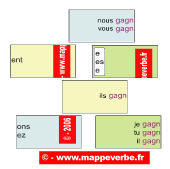The indicatif présent is the most
important tense, because when you know the stems (up to three: Stem
1, Stem 2, Stem 3) a verb uses in this tense, you can form at least
four other tenses out of them:
-
the
impératif présent use Stem 1 and Stem
3;
-
the subjonctif présent use Stem 2 and Stem
3;
-
the indicatif imparfait use Stem 3;
-
the
participe présent use Stem 3.
as the different coloured branches on the map
show.
A verb can indeed use up to three stems in this
tense:
-
Stem 1,
with subject pronouns je, tu, il/elle/on,
-
Stem 2,
with subject pronouns ils/elles,
-
Stem 3,
with subject pronouns nous, vous.
The table below shows four verbs which illustrate
these changes:
The verb gagner (to win) uses a
single stem. The verbs battre (to beat) and
voir (to see) use two
different stems, but the change occurs in two different
places:
-
with
subject pronouns ils/elles, for the verb battre (to beat);
-
with
subject pronouns nous, vous, for the verb voir (to see).
As for the verb prendre (to take), it uses
three different stems.
Therefore, the stems in the indicatif
présent can change in only two places:
-
with
subject pronouns ils/elles,
-
and/or
with subject pronouns nous, vous.
However, for most verbs (verbs formed like
gagner), the stem
never changes. It means that:
The stem combinations for the other verbs
are:
-
 e.g. battre (to beat)
e.g. battre (to beat)
-
 e.g. voir (to see).
e.g. voir (to see).
-
 e.g. prendre (to take)
e.g. prendre (to take)
être (to be) , aller (to go), avoir (to have), faire (to do or
make) and their compounds.
(re-)dire (to say) with
subject pronouns vous.
Learning the Indicatif
présent is fun:
 |
Visit
www.conjugaison.fr (in French)
and
assemble more than 50 puzzles,
most
of them
dedicated to the learning of the
Indicatif présent. |
Only the endings ons and ez
are always pronunced. However, to make liaisons with words starting
with a vowel or a mute h, you can pronounce:
-
the
s,
x, t: Examples: je
veux aller, elle peut
arriver, elle peut en faire, tu
dois en prendre, etc.
-
the
t of ent: Examples: ils
mangent encore, elles ouvrent
à 8 heures, ils se rendent à
Paris, etc.